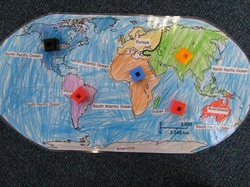O-Level Geography Exam Papers
Each paper will ask you questions on your Knowledge/ Understanding and Enquiry Skills. You will be asked to answer all the questions in the paper.
A variety of question types will be included ; most questions will be resource based (maps, tables, graphs, sketches, cartoons) and at least one OS map-based question will be in each paper.
A variety of question types will be included ; most questions will be resource based (maps, tables, graphs, sketches, cartoons) and at least one OS map-based question will be in each paper.
Foundation grades 5 & 6 - 1 hour 5 mins
General - grades 3 & 4 - 1 hour 25 mins
Credit - grades 1 & 2 - 2 hours
- There are usually about 12 questions to answer in the paper.
- Questions are very clear and easy to understand and worth one or two marks.
- The questions will include maps, sketches, graphs, cartoons.
- You write your answers in the exam booklet in the spaces provided.
- You are asked to give short answers and explanations.
- The answer space given will give you a clue to how long your answer should be.
- Some questions will be multiple choice options.
- Some questions will ask you to match the correct letter to the appropriate answer.
General - grades 3 & 4 - 1 hour 25 mins
- There are usually about 10 questions to answer.
- Questions are very clear and easy to understand and worth 2, 3 or 4 marks.
- The questions will include maps, sketches, graphs, cartoons.
- You write your answers in the exam booklet in the spaces provided.
- Answers are longer and more detailed than in the Foundation paper.
- The answer space given and the marks for the question will give you a clue to how long your answer should be.
Credit - grades 1 & 2 - 2 hours
- There are usually 8 questions to answer in this paper.
- The questions are more demanding.
- More complex sources (maps, sketches, graphs, cartoons) are used to test your knowledge and skills.
- Unlike the F & G papers your answers are written in a separate answer booklet.
- Answers should be detailed.
- The marks each question is worth will give you a clue to how detailed your answer should be.
Types of Questions

Knowledge / Understanding
Worth 40% of the marks in the exam.
This means you have to remember some facts, ideas, processes and issues you have studied. Be able to use these in answers to questions. Make sure you know what certain key words mean e.g. erosion, deposition....
You will also be expected to show that you understand the processes, patterns and features
You might be asked to draw a diagram or sketch to show you have understood.
Enquiry skills
Worth 60 % of the marks in the exam.
Given information in the questions you will be able to:
Worth 40% of the marks in the exam.
This means you have to remember some facts, ideas, processes and issues you have studied. Be able to use these in answers to questions. Make sure you know what certain key words mean e.g. erosion, deposition....
You will also be expected to show that you understand the processes, patterns and features
You might be asked to draw a diagram or sketch to show you have understood.
Enquiry skills
Worth 60 % of the marks in the exam.
Given information in the questions you will be able to:
- state the main points and or relationships of the information
- draw conclusions which relate to the information given in the question
- express a point of view based on the information
- identify techniques for processing information and being able to justify your choice.
Understanding the Questions
Standard grade examinations are not trying to catch you out. Questions may not be about places you have studied, but they will give you the chance to show what you know, understand and can do in geography.
It is really important, when you are keen to get on with the exam paper, that you read and understand the questions, or you may answer them the wrong way and lose marks.
Here are some words that are used in the Standard Grade questions. Do you know exactly what the are telling you to do?
It is really important, when you are keen to get on with the exam paper, that you read and understand the questions, or you may answer them the wrong way and lose marks.
Here are some words that are used in the Standard Grade questions. Do you know exactly what the are telling you to do?
- Compare / Contrast - identify and write down the things that are the same and are different between the features or places in the question.
- Complete - you might be asked to finish off a diagram, map or graph.
- Define - describe or explain the meaning of something.
- Describe - write down things about what is shown on a map, table or graph. Say what you see in detail and quote the data.
- Discuss - usually requires a longer answer as you are describing and giving reasons or explaining arguments for or against.
- Do you agree - Tick your choice YES or NO
- You are being asked to make a choice between the given answers.
- Draw / Annotate - you might be asked to draw a sketch or diagram with labels to explain the formation of a feature - e.g. - meander, corrie.
- Explain (Account for) / Justify / Give a reason / Give detailed reasons / Suggest reasons / Argue a point of view - give reasons for the location or appearance of a feature.
- Give your views - you might be asked to say what you think or what another person or group might think.
- Identify - name, locate, recognise or select a particular feature or features from a map, photograph or diagram.
- Locate - write down where a feature or place is.
- Name, state or list - write down accurate details or information.
- Study / Look at - look carefully at a map, diagram, sketch, table and think about what it shows.
- Technique - refers to either a gathering or processing technique.
- Using map evidence (OS Maps) - you must give a 4 figure grid reference (Foundation/General) or 6 figure grid reference (Credit), and / or mention a place, name or feature taken from the map.
- With reference to (or refer to) - examples that you have studied - you need to give detailed and specific information about the case study when explain the reasons for a particular answer.
- With the help of or using the information provided - be sure to use and mention examples from the information (e.g. tables, graphs) in the paper to explain your answer.
Advice from the Examiner

Always try to use geographical words when you are writing your answer. For example, if you are describing places on a map, use compass directions to describe where they are in relation to each other e.g. "the river flows from the south west to the north east of the map".
In a question were you have been asked to use a source of information - diagram, map, table always refer to that source in your answer.
You are often asked to describe graphs:
In a question were you have been asked to use a source of information - diagram, map, table always refer to that source in your answer.
You are often asked to describe graphs:
- With a line graph mention any changes to the line (rising, falling, level) and how quickly these changes take place (slowly rising, falling quickly, stayed level for some years)
- With a Bar or Pie chart compare the size of the different bars or sectors and mention the relative importance of each (e.g. housing takes up 60% of the area).
Filling your Answers

- You have to answer ALL questions so just start at the front of the paper and work your way to the end.
- Before you start answering a question make sure you have read it through and understand what you are being asked to do.
- Write as quickly and as clearly as you can. Take care with your spelling.
- Draw large, clearly labelled diagrams when asked.
- Spend longer answering questions with more marks.
- If you are unsure about a question, move on and come back to it later.
- You may find that some questions are more difficult than others.
- The mapwork question (question 1) accounts for approximately 20% of all marks. Don’t panic if you feel this takes longer than others.
- The mapwork question will need map evidence. For every answer relating to the map, make sure you add in appropriate Grid References or place names to show that you have looked at the map.

